How to Make Prickly Pear Syrup
September 21, 2015 | Updated June 17, 2020
As an Amazon Associate I earn from qualifying purchases.
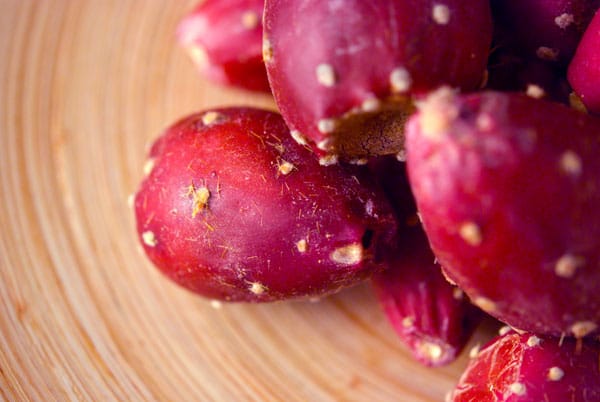
Well into my adulthood, all I knew about prickly pears was that they are the fruit of a cactus, the Sicilians eat them, and that according to Baloo, they are a bear necessity. I’d filed them in the back of my mind to the “someday I’ll get to it” list, along with perfecting bechamel and giving a crap about edible foams.
But when I moved to California years ago, I saw them everywhere.
Prickly pears are a common landscaping plant, one I’ve taken to growing in my own yard.
The fruits, often called tunas, come in all sizes and colors, ranging from teeny to larger than an orange. The larger ones are worth eating as a fruit, but the little ones are best for prickly pear syrup, which is what I first made with this fantastic cactus fruit.
The first time I brought some home, life intervened and they sat in my fridge in that paper bag for nearly a month. Apparently prickly pears store really well in the fridge. I’ve since kept them in a paper bag in the truck for a week and they were fine.
If you want to eat the fruit, you need to get these little flavor grenades out of their spiky skins. Second lesson learned: It’s not the big, seemingly vicious spines you need to worry about. It’s the hairlike “glochids,” which cover the fruit, that you need to worry about. Hated, evil glochids. Even the name sounds like some monster in a George Romero film.
Instead of skinning, you can also torch the pears briefly, which burns off the glochids. My friends Elise and Garrett have a method for skinning prickly pears that works well, too.
Regardless of how you use your tunas, you need to separate the seeds from the pulp. Garrett and several others say the seeds are edible, but they are either high or have far stronger teeth than I do; it’s like eating a wood chip.
Prickly Pear Syrup is dead easy. No skinning or burning required. Simply cover the fruits with water, bring to a boil, cover and let steep for 30 minutes or so. Mash with a potato masher, run through a food mill to remove the seeds, and then strain, strain strain.
I am something of a fanatic when it comes to clarity; I developed this particular neurosis from making wine. So I pass the pulpy juice through a fine-meshed sieve and then again through cheesecloth or a plain paper towel.
After that, I add an equal volume of sugar and bring it to a simmer to thicken a little. Once the sugar was good and dissolved, I turned off the heat and added some citric acid.
Why? Third lesson learned: Prickly pears, which taste like a combination of bubble gum, watermelon and strawberries, are mostly lacking in tartness. An exception is the variety the Mexicans call xoconostle. Without tartness, fruit is not very tasty.
Why citric acid? I wanted a neutral acid, not lemon juice. They’re close, but not the same. Lemons bring other flavors to the party, and I wanted this to be prickly pear’s show.
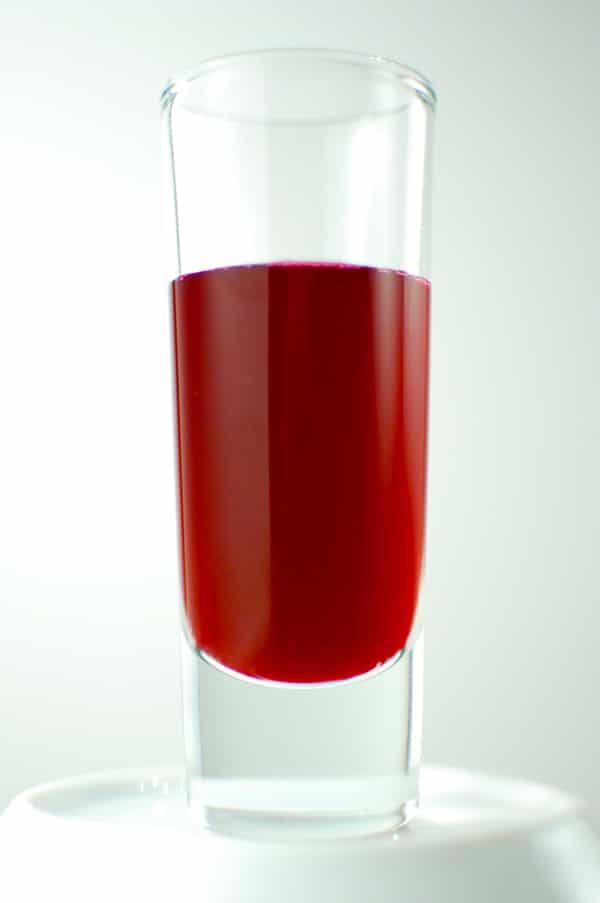
The result? Pure magenta power.
This prickly pear syrup rocks. The citric acid gives it just the right tang, and it brings out the watermelon-bubblegum elements and holds the color; it’s also a good preservative.
My initial use: Mixed with tequila, of course. Cactus and Agave. Duh! After that obligatory start, you can make sorbet, a vinaigrette for a salad, a souffle, or a glaze for game birds. If you want to do that, here is a glazed pheasant recipe that works just fine with a regular chicken (or quail or grouse), as well as with other glazes such as maple syrup, honey or another fruit syrup.
What’s the takeaway? Stretch a bit. Expand your horizons and work with new flavors. Some, like this one, will become new staples for your personal kitchen.
Prickly Pear Syrup
Ingredients
- 3 pounds prickly pears
- Water to cover
- 3 cups sugar
- 1 tablespoon citric acid, or the juice of 2 lemons
Instructions
- Put the fruits in a pot and add enough water to almost cover them. Cover and bring to a boil. Turn off the heat and let steep for 30 minutes.
- Mash the fruit with a potato masher, then push it through a food mill to separate out the seeds.
- Strain the pulpy juice through a fine-meshed strainer, then again through the same strainer that has either cheesecloth or a plain paper towel set inside. You need to do this to be sure of removing every last glochid.
- Measure the strained juice, and pour it into a pot. Add an equal amount (by volume) of sugar and bring to a simmer over medium heat. Let it simmer for 5 minutes. Turn off the heat and let it cool for 15 minutes. Add the lemon juice or citric acid. Add a little at a time and taste it. Stop adding when it is tart enough for you.
- Pour while still hot into clean Mason jars and seal. This should keep for months in the fridge, or you could process it in a boiling water bath for 10 minutes and keep it in the pantry; the citric acid helps preserve the syrup.
Notes
Nutrition
Nutrition information is automatically calculated, so should only be used as an approximation.

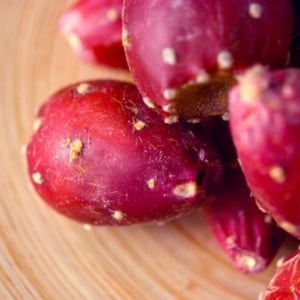
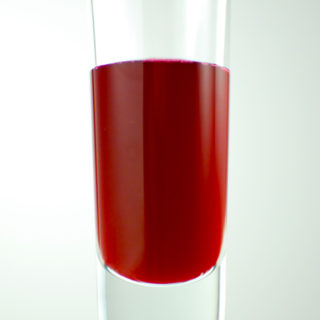
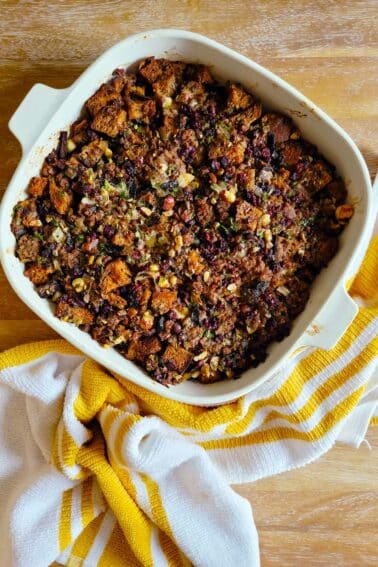
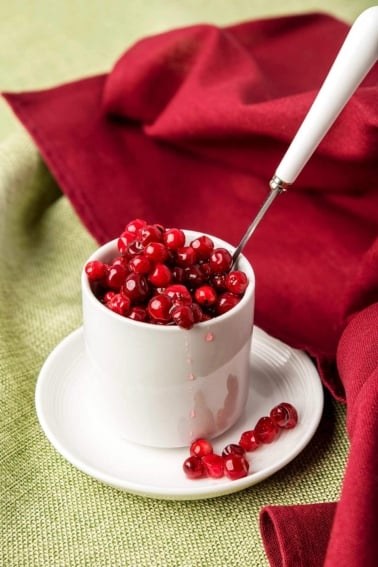
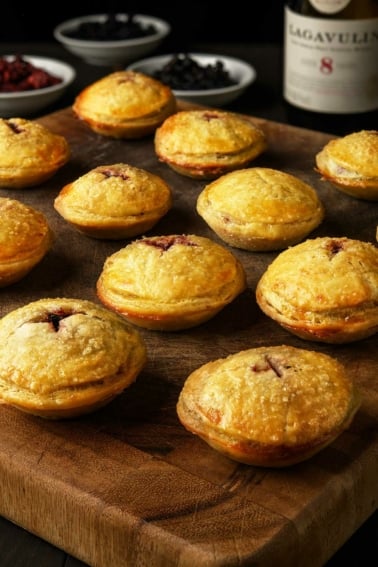

I burnt the prickles off the pears over my gas stove, then holding them with tongs and gloved hands, used a stiff vegetable brush on them and rinsed them off. Then I put them in a bowl, and followings a Southern Utahan’s advice, stuck the bowl in the freezer for a few days. I let them thaw out, and used a potato masher to easily crush them (the magic is in the freezing) with gloved hands, to crush the 13 pears I had. I pressed them through a sieve. I filtered that juice through cheese cloth three times for clarity and ended up with 2 cups of juice. I used a Meyer lemon instead of citric acid, and it tastes delightful. I canned them in 8 oz jars (ended up with 3) and processed them for 10 minutes in a water bath.
Hi Hank,
Thanks for this recipe! I’m in Prescott AZ and harvested from 3 of my neighbors large prickly pears. I have quite a load now over 15 lbs. I froze some (skin on, burned off the stickers) for later experiments and started with a small batch of about 4 lbs (my first try at this). I did burn off the stickers, did not peal. I didn’t have a food mill so I used an immersion blender before straining as the potato masher wasn’t working for me with the skins still on. I love the beautiful color and the taste is fabulous in a gin and tonic instead of limes!! WOW!
My question is, it’s very thin like water; is there a way to make it a bit thicker more like syrup?
Holly: you can cook it down, but you lose that pretty color.
Dead liquid. Followed the directions, added time for elevation. It’s not even remotely close to a jelly. Will add more pectin tomorrow as shared on another recipe….
JF: Um… it’s not a jelly. It’s a syrup. It is supposed to be a liquid. Why would you think this is a jelly?
Do you have to peel the prickly pear and just boil the inside of it? ThNk you
Hi Hank, thanks for this recipe. I was actually using Monin’s Desert Pear syrup to make a Pear Moonshine. I added high proof moonshine to syrup and water to make a 40% spirit. Tasted amazing but a week later it turned brown. I was curious if this was due to the cactus or something in the syrup?
Anything like this happen in your experiences?
Thanks in advance.
Carlo: Yep. It oxidized. Prickly pear color is very susceptible to that.
Thanks Hank! Have made this a second time as peak prickly pear season and a fun August activity for my neighbor (her first time) and myself today. Looking forward to sharing the delicious syrup and appreciate your sharing the recipe! Jackie in Carefree, AZ
is the fruit boiled without peeling it? whole?
Bonita: Yes. It is then crushed and juiced and run through a sieve to remove the spines.
This was wonderful, and well worth it! I searched some prickly pears from a neighbors yard, with their permission of course, and couldn’t be happier with the tasty results 🙂
Have you tried using a steam juicer? That’s what we use to juice the tunas. I’m curious how different the end products are using the different methods.
Rachel: I have not tried using one, as I don’t have one. Sorry.
Can I use a sugar substitute like Stevia to make this? Also, will green the green fruit work for this? Thanks
Jo: No idea on sugar substitutes, sorry. I don’t know much about them. And no, green fruit won’t work. It needs to be ripe.
Have you ever canned the syrup? Would there need to be changes to the recipe? Thanks!
Ian: You shouldn’t need to. A 1:1 syrup is shelf stable. It won’t ferment.
Do you use the water you boil the fruit in as part of the syrup or only the juice from the mashed fruit? I’m not sure if the boiled water releases some of the juice from the fruit or not, so I wanted to ask before I try.
Dave: Yes, I use the water I boil the fruit in, too.
If I just pour this into swing top bottles and refrigerate will it still last months in the refrigerator? And will lime work instead of lemon?
Melissa: Yes and yes.
Super easy recipe! I really appreciated that since I don’t “can” things therefore, I don’t have any fancy equipment. Like a steam juicer huh? ?
This was my second Prickly Pear Syrup attempt and I have been pleased with both!
Thanks for this easy version .
I have found that it makes an excellent substitute in A Tequila Sunrise or a delicious substitute in a Cherry Coke.
If you are using lemons in place of citric acid, do you still need about a tablespoon? The “juice of two lemons” varies widely on the type of lemon. For example my Meyer lemons that’s about 1/2-3/4c but store bought lemons I’m lucky if I get 1/4 c with two lemons. Or is more of a taste thing?
Christine: It’s a taste thing. The high sugar level is what preserves this syrup.
I don’t think sugar preserves. It’s citric acid. Yes?
Michael: Nope, sugar is an excellent preservative in high amounts, like in this syrup. A full syrup, i.e., 1:1 sugar to juice, is shelf stable because nothing can live in it. Anything less can ferment.
To remove the stickers I put a few tunas in the colander and agitate under running water. They come off easily and then I can handle them. Still filter to be sure. Love making jelly for meat dishes.